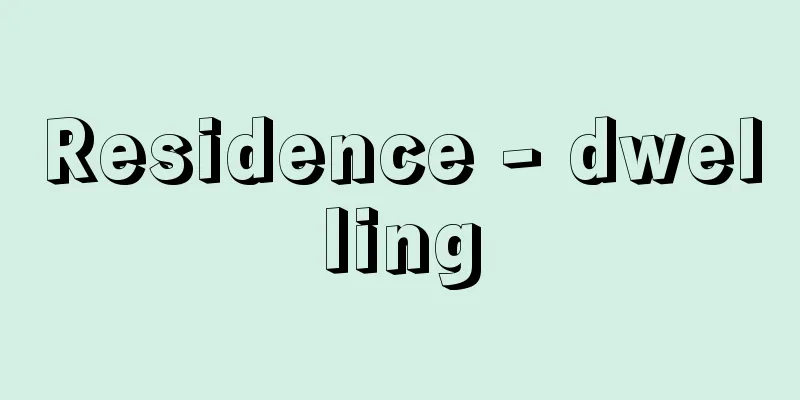Residence - dwelling

|
As the expressions "food, clothing and shelter" indicate, housing is one of the basic conditions of human life. Words such as "house" and "dwelling" are often used to refer to housing as a structure, but the word "dwelling" does not simply refer to a building. A structure can only be called a dwelling when human life is carried out within it. The word "dwelling" can also be used when humans live in natural objects such as caves that have been barely altered by human hands. In other words, when a certain amount of space is used as a place for humans to live, regardless of whether or not humans have made any changes to it, it is called a dwelling. [Hiroyuki Kurita] Functions of the residenceThe most basic function that a home fulfills in human life is as a shelter, protecting people from the outside world. A home protects people from natural forces such as rain, wind, heat, and cold, allowing them to carry out a variety of activities smoothly. In addition to these natural forces, the outside world also contains wild animals, poisonous animals, and hostile humans, and homes protect people from these external enemies. In addition to serving as a shelter, homes also have a variety of other functions, such as serving as a place to lead a social life and fulfilling ceremonial and religious roles, but the functions that homes fulfill vary from society to society and region to region. Similarly, human activities carried out within a dwelling are also diverse. Sleeping and resting within a dwelling is a fairly common phenomenon. Furthermore, activities such as cooking food, eating, sexual intercourse, excretion, child rearing, and the keeping of possessions are also often carried out within a dwelling. There are often cases where functions are differentiated between buildings, with certain activities being carried out in different buildings, such as bedrooms, kitchens, dining rooms, toilets, and storerooms. However, if we consider that a dwelling and a house are essentially separate entities, this is not so different from a case in which functions are differentiated between rooms within a single house, and these buildings can be considered together as one dwelling. In addition to the above, various other activities are carried out within a dwelling, but which activities are carried out within a dwelling also differs from society to society and region to region. As is clear from the above, it is extremely difficult to give a strict definition of the concept of residence. Residence cannot be defined by extracting one function or one action. It would be more appropriate to separate residence from the building and to grasp it as a kind of spatial concept, but the concept itself would remain vague. [Hiroyuki Kurita] Natural environment and housingWhen we look at the function of a house as a shelter, we can see a close relationship between the type of house and the natural environment. In cold regions, it is necessary to use heating to raise the room temperature and to further increase heat retention. The most common heating method is to light a fire inside the house using a hearth, but there are also underfloor heating such as in the Korean ondol and wall heating such as in the Russian pechka. In addition, semi-underground dwellings such as pit dwellings and methods of sealing the walls and roof are used to increase heat retention. Eskimo igloos, dwellings made of frozen snow, have very high heat retention and are well adapted to the climate around the Arctic Circle. Semi-underground dwellings found in Siberia and northwestern America also increase heat retention by sealing the above-ground parts with soil. In contrast, in tropical regions, the issue is how to lower room temperatures. A common method is to increase ventilation within the dwelling. This is often done by utilizing gaps in the walls to increase ventilation, but in the pile dwellings found from Southeast Asia to Melanesia, the floor is raised off the ground to ensure even better ventilation. In contrast to these open dwellings, methods of increasing the closed-off nature of the dwelling are sometimes adopted to prevent the intrusion and influence of hot outside air. This is why highly closed-off dwellings with thick mud or adobe walls are found in Southwest Asia and North Africa. Meanwhile, the amount of precipitation also has various effects on housing types. In areas with heavy rainfall, sloping roofs are used to prevent rain from entering the interior of the home. To prevent rainwater from entering from the ground surface, a frame is installed at the entrance to the home, and dwellings are built on raised floors or on piles. Conversely, in areas with little rainfall and dry areas, a simple or flat roof is sufficient. In areas with heavy snowfall, dwellings have been developed with structures that can withstand the weight of accumulated snow, and steeply sloping roofs are used to prevent snow from accumulating. The natural environment not only influences the type of dwelling, but also provides the materials for it, and the type of dwelling changes depending on what materials are available. In arid regions and other areas where wood is difficult to obtain, materials such as soil, adobe bricks, and stone are used. In the case of Eskimo igloos, frozen snow is used. When it comes to the use of wood and other plants, the type of dwelling naturally differs between areas where straight timber such as conifers can be used and areas where only low shrubs can be used. In addition, a variety of materials are used, such as animal skins for tent-style dwellings, cow dung mixed with soil for mud walls, and grass, straw, and palm leaves for roofing materials. [Hiroyuki Kurita] Culture and HousingAs mentioned above, it is clear that the natural environment has a great influence on housing forms, but the natural environment by no means determines the housing form. There are examples all over the world of people living in similar natural environments having different housing forms due to different livelihoods or cultures. Regarding materials, the types of materials that can be used vary depending on the technology that people possess, and even if the same materials are used, the housing form will differ depending on the technology. Therefore, a simple environmental determinism regarding housing form does not hold up. Housing issues are also cultural issues. [Hiroyuki Kurita] Occupation and residenceFirst, the type of dwelling is related to the type of livelihood. For hunter-gatherers, nomads, and other people who live a mobile lifestyle, their dwellings must be suitable for that mobile lifestyle. The dwellings of the San people of Africa, the Negrito people of Southeast Asia, and the Australian Aborigines are nothing more than windbreaks, and are disposable dwellings that can be built in a short time at their new home and left behind when they move on to their next destination. Tent-style dwellings, which are easy to assemble and dismantle, are also often used by people who lead nomadic lifestyles. The chum used by Siberian hunters and the tepee used by indigenous hunter-gatherers in North America are small cone-shaped tents made from animal skins and other materials. Tents consisting of a roof and walls are also used by nomadic peoples in Siberia, Mongolia, Central Asia, Western Asia, and North Africa, and animal skins and other materials are used for the tent. This type of tent is called a yurt in China, a ger in Mongolia, and a yurt in Siberia. On the other hand, agricultural people who are more settled generally use more fixed dwellings. In the case of slash-and-burn agriculture, there is some mobility, but the migration cycle is relatively long and dwellings are still fixed. People who engage in fishing are roughly similar to hunter-gatherers, but when fishing by boat, the boat itself sometimes serves as a dwelling. Also, on Lake Titicaca in Peru, Indians who engage in fishing live on floating islands made of reeds, and sometimes move the floating islands themselves. Additionally, in Southeast Asia, Melanesia and South America, there are examples of dwellings built on piles above the water, but these people do not necessarily make fishing their main occupation. [Hiroyuki Kurita] Social Structure and HousingThe form of housing is also closely related to social structure. It is common for one family to live in one house, but there are many types of family, including nuclear families, lineal families, extended families, joint families, and polygamous families, and the type of relatives who share one house varies from society to society. This is also closely related to whether the society is monolineal or bilineal. Non-relatives often live together, and one family may live in multiple houses. In the longhouse type of housing found in Southeast Asia, Melanesia, and North America, many family members live in one long house. When various relatives and non-relatives live in one house, it is necessary to consider how the space within the house is divided, which parts are shared, and which parts are exclusive to each person. Often, the house is largely divided into spaces for each nuclear family. In societies with clear separation between men and women, the house may be divided into men's and women's spaces. In many cases, men live in the man's house and women in the woman's house, and in societies where polygamy is common, the husband may live in the man's house and the wife in her own house. There are also cases where men live together in one man's house and women in a smaller woman's house. In societies where age-group organization is well developed, an age group may share a house, for example, a youth hostel and a girls' hostel. As these various examples show, it is often not enough to treat each dwelling as an isolated entity. In some cases, such as African compounds, where multiple houses on a single site are organically connected, and there are also examples of one village with one longhouse, it is impossible to understand various forms of housing without considering the relationship between human groups and living space, such as families, kinship groups, villages, and local groups. [Hiroyuki Kurita] Ceremonies and residenceHouses are also often linked to religion and rituals. There are examples all over the world of houses being used as places of rituals, or of altars being placed within the house. The location of a house is also often determined by religious significance. The orientation of a house is determined by its direction, such as north-south, east-west, sea-mountain, upstream-downstream, and so on, in Bali and other parts of the world. There are also many examples of the division of space within a house being linked to symbolism, such as the sacred and the profane, the pure and the impure, the right and the left, and up and down. In addition, in parts of eastern Indonesia, the house is spoken of in the image of the body, as if it were the womb, and the house is considered a microcosm, and it is a widely seen phenomenon in which the house is linked to a worldview or cosmology. For information regarding the history of Western and Japanese housing, and modern residential architecture, please refer to the "Housing" section. [Hiroyuki Kurita] "Anthropology of Residential Space" by Naomichi Ishige (1972, Kajima Institute Publishing)" ▽ "Prototype of Housing I" edited by Yasukazu Izumi (1971, Kajima Institute Publishing)" ▽ "Prototype of Housing II" by Takamasa Yoshizaka et al. (1973, Kajima Institute Publishing)" [Reference item] |Source: Shogakukan Encyclopedia Nipponica About Encyclopedia Nipponica Information | Legend |
|
衣食住という表現が示すように、住居は人間生活の基本条件の一つである。建築物としての住居に対しては、家屋や住宅などのことばがしばしば用いられるが、住居ということばは単に建築物のみを指し示すわけではない。建築物の中で人間の生活が営まれて初めてそれは住居とよびうる存在となるのである。また、人間の手がほとんど加わっていない洞窟(どうくつ)などの自然物を利用して、その中で人間が生活するような場合にも、住居ということばを用いることができる。すなわち、人間が手を加えるか加えないかにかかわらず、ある一定の空間を、人間が生活を営む場として利用するとき、それが住居とよばれるのである。 [栗田博之] 住居の機能住居が人間生活に対して果たすもっとも基本的な機能は、人間生活を外界から保護するというシェルターとしての役割である。住居によって人間は雨や風、暑さや寒さなどの自然の力から保護され、さまざまな行為を円滑に進めることができる。また、これらの自然力のほかにも、外界には猛獣、毒をもった動物、敵対関係にある人間などが存在し、住居はこれらの外敵からも人間を保護してくれる。このシェルター(避難所)としての役割のほかにも、社会生活を営む場としての役割、儀礼的・宗教的な役割など、住居はさまざまな機能をあわせもっているが、住居がどのような機能を果たしているかは、社会ごとに、また地域ごとに異なっている。 これと同様に、住居内で行われる人間の行為も多種多様である。睡眠や休息を住居内でとるというのは、かなり一般的な現象である。また、食物の調理、食事、性交、排泄(はいせつ)、育児、所有物の保持などの行為も住居内で行われることが多い。寝室、台所、食堂、便所、倉庫など、ある行為が別の棟で行われるという、棟ごとに機能が分化している場合もしばしばみられるが、これは、住居と家屋とはいちおう別のものであるという点を考慮すれば、一つの家屋内で室ごとに機能が分化しているという場合と大差なく、それらの棟をまとめて一つの住居であると考えればよい。このほかにも、さまざまな行為が住居内で行われるが、どの行為が住居内で行われるかは、やはり社会ごとに、また地域ごとに異なっている。 以上から明らかなように、住居という概念を厳密に定義することは非常にむずかしい。ある一つの機能、あるいはある一つの行為を取り出して、そこから住居を定義することはできないのである。住居というものを、いちおう建物と切り離して、一種の空間概念としてとらえるほうが適切であろうが、やはりその概念自体もあいまいなものとしてとどまってしまうのである。 [栗田博之] 自然環境と住居シェルターとしての住居の機能に注目すると、住居の形態と自然環境の間には密接な関連がみられる。寒冷な地域では、暖房を用いて室温を上げ、さらに保温性を高めることが必要となる。暖房方法としては、炉(ろ)を用いたりして室内で火を焚(た)く方法が一般的であるが、朝鮮のオンドルなどの床下暖房や、ロシアのペチカなどの壁面暖房などもみられる。また、保温性を高めるためには、竪穴(たてあな)住居のような半地下式住居を用いたり、壁面や屋根の部分を密閉したりする方法などが用いられる。エスキモーのイグルーとよばれる、凍結した雪を用いた住居の場合、保温性が非常に高く、北極圏周辺の気候にみごとに適応している。シベリアや北西アメリカにみられる半地下式住居の場合も、地上部を土で密閉することによって保温性を高めている。 これに対し、熱帯周辺地域では、いかに室温を下げるかが問題となる。一般的にみられるのは、住居内の通風性を高めるという方法である。壁面のすきまを利用して通風性を高める場合が多いが、東南アジアからメラネシアにかけてみられる杭上(こうじょう)住居では、床面を地表面から離すことによって、よりいっそうの通風性が確保されている。この開放性の住居とは逆に、熱い外気の侵入や影響を避けるために、閉鎖性を高めるという方法が採用されることもある。厚い土壁や日干しれんがの壁を用いた閉鎖性の高い住居が西南アジアや北アフリカにみられるのは、このためである。 一方、降水量も住居形態にさまざまな影響を与える。多雨地帯では、傾斜屋根を用いて、室内への雨の侵入を防ぐ。また、地表面からの雨水の侵入を防ぐために、住居の入口に框(かまち)を設けたり、高床(たかゆか)式住居や杭上住居を用いたりする。逆に、少雨地帯、乾燥地帯では、簡素な屋根あるいは平屋根などで十分である。また、多雪地帯では、積雪の重みに耐えうるような構造の住居が発達し、急傾斜の屋根によって積雪を防いだりしている。 自然環境は住居の形態に影響を与えるだけでなく、住居の材料を提供するものでもあり、どのような素材が入手可能かによって、住居の形態は変化してくる。乾燥地帯など、木材の入手が困難な地域では、土や日干しれんが、石材などが利用される。エスキモーのイグルーの場合には、凍結した雪が利用される。木材など植物の利用に関しても、針葉樹などの直材が利用可能な地域と、低灌木(ていかんぼく)などしか利用できない地域とでは、当然住居の形態も異なってくる。このほか、動物の皮をテント式の住居に用いたり、牛糞(ぎゅうふん)などを土に混ぜて土壁に用いたり、草や藁(わら)、ヤシの葉などを屋根材として用いたりするなど、さまざまなものが材料として用いられている。 [栗田博之] 文化と住居以上のように、自然環境が住居の形態に大きな影響を与えていることは明らかではあるが、けっして自然環境が住居の形態を決定しているわけではない。同じような自然環境のなかで生活している場合にも、生業形態が異なったり、文化が異なったりするために、住居の形態が異なっているという例が世界各地にみられる。材料に関しても、人々のもつテクノロジー(技術)によって、どのような素材が利用できるかが異なってくるし、また、同じ材料を利用したとしても、テクノロジーによって、住居の形態は異なってくる。したがって、住居の形態に関する単純な環境決定論は成立しない。住居の問題は文化の問題でもあるのである。 [栗田博之] 生業形態と住居まず、住居の形態は生業形態と関連している。狩猟採集民、遊牧民など、移動生活を行う場合には、住居もその移動生活に適したものでなければならない。アフリカのサン人、東南アジアのネグリト、オーストラリア先住民などの住居は、単なる風よけにすぎないようなものであり、移動先で短時間のうちにつくることができ、次に移動する際にはそのまま放置しておくような使い捨ての住居である。 組立て・解体の容易なテント式の住居も、移動生活を営む人々によってしばしば用いられる。シベリアの狩猟民が用いるチュム、北アメリカの採集狩猟に従事する先住民の用いるティピは、円錐(えんすい)形の小型のテントであり、動物の皮などがテント地として用いられる。また、屋根と壁面からなるテントは、シベリア、モンゴル、中央アジア、西アジア、北アフリカの遊牧民の間で用いられており、動物の皮のほか、布地などをテント地として用いる。中国でパオ、モンゴルでゲル、シベリアでユルトとよばれるものが、この型のテントである。 一方、定住度の高い農耕民の場合には、より固定的な住居が一般に用いられている。焼畑農耕の場合、多少移動性がかかわってくるが、移動周期は比較的長く、やはり住居は固定的である。漁労に従事する人々の場合は、ほぼ狩猟採集民の場合に準ずるが、船を利用した漁労の場合には、船自体が住居の役割を果たすこともある。また、ペルーのティティカカ湖では、漁労に従事するインディオが葦(あし)でつくった浮き島の上に居住しており、ときには浮き島ごと移動することもある。このほか、東南アジアやメラネシア、南アメリカでは、水上に杭上住居を建てる例がみられるが、これらの人々はかならずしも漁労をおもな生業としているわけではない。 [栗田博之] 社会構造と住居住居の形態は、また、社会構造とも密接に関連している。一つの住居に一家族が居住するという場合が一般的ではあるが、単に家族といっても、核家族以外に、直系家族、拡大家族、合同家族、複婚家族などがあり、どのような親族が一つの住居を共有するかは、社会ごとに異なっている。また、これには、単系社会であるか、双系社会であるかも深く関係している。非親族成員が同居する場合もしばしばみられるし、一家族が複数の住居に分かれて住むこともある。東南アジア、メラネシア、北アメリカなどでみられるロングハウスという住居形態では、一つの長大な家屋の中に多数の家族が居住する。一つの住居にさまざまな親族成員や非親族成員が居住している場合には、住居内の空間がどのように分割されているか、どの部分が共有され、どの部分がだれに専有されているかを考えなければならない。しばしば、住居内が大きく核家族ごとの空間に分割されていることがある。また、男女の分離が明確な社会では、住居内が男性の空間と女性の空間に分割されていることもある。これがさらに進んで、男性は男性の家に、女性は女性の家に住むという場合も多く、一夫多妻婚がみられる社会では、夫は男性の家に、妻は各自の女の家に住むという場合もある。また、男性は共同で一つの男性の家に、女性は、より小さな女性の家に住むという例もみられる。年齢集団の組織が発達した社会では、たとえば若者宿や娘宿のように、一つの年齢集団が一つの住居を共有するという場合もある。これらさまざまな例が示すように、住居を一つ一つ孤立したものとして扱うだけでは十分でない場合も多い。アフリカのコンパウンドのように、一敷地内にある複数の家屋が有機的に結び付いている場合があるし、1村落1ロングハウスというような例もあり、家族、親族集団、村落、地縁集団など、人間集団と居住空間の関係を考えなければ、さまざまな住居の形態を理解することはできないのである。 [栗田博之] 儀礼と住居住居は、また宗教や儀礼と結び付いている場合が多い。住居が儀礼の場となったり、住居内に祭壇などが置かれたりする例は、世界各地にみられる。また、住居の位置が宗教的な意味から決定されることも多い。東西南北、海と山、上流と下流など、住居の向きを方位によって定めるということも、バリ島をはじめとして、世界各地で行われている。また、住居内の空間の分割が、聖と俗、清浄と穢(けが)れ、右と左、上と下などのシンボリズムと結び付いている例も多い。このほか、東インドネシアの一部で、住居が母胎と同一視されるように、住居が身体のイメージで語られたり、住居が小宇宙と考えられたりするなど、住居が世界観や宇宙論と結び付くという現象も広くみられる。 なお、西洋、日本の住宅の歴史、現代の住宅建築に関する諸事項については、「住宅」の項目を参照されたい。 [栗田博之] 『石毛直道著『住居空間の人類学』(1972・鹿島研究所出版会)』▽『泉靖一編『住まいの原型Ⅰ』(1971・鹿島研究所出版会)』▽『吉阪隆正他著『住まいの原型Ⅱ』(1973・鹿島研究所出版会)』 [参照項目] |出典 小学館 日本大百科全書(ニッポニカ)日本大百科全書(ニッポニカ)について 情報 | 凡例 |
Recommend
pluriarc
...In addition, the arpa, which was introduced by...
Moskvin, Ivan Mikhailovich
Born June 18, 1874 in Moscow [Died] February 16, 1...
On Ok - On Ok
In 583, the Western Turks became independent and ...
Forceps bite - Kanshijoukougou
...The ridge from the space between the eyebrows ...
Holothuroidea
…A general term for echinoderms belonging to the ...
Awa Shijira - Awashijira
A type of cotton fabric, this is a summer kimono f...
Iznik [Lake] - Izuku
...A town in Bursa Province located in western Tu...
Collected Works of Bai
A collection of poems and prose by Bai Juyi. This...
Tsubame [city] - Swallow
A city in the central part of Niigata Prefecture, ...
Southward Advancement Theory
A debate on foreign policy in modern Japanese hist...
Fox Fist - Kitsuneken
A game similar to Janken, in which players compete...
Ortho-jiazine - Ortho-jiazine
...A six-membered aromatic heterocyclic compound ...
Sumo topknot - Sumo topknot
Hairstyles for sumo wrestlers. In the sumo ring, w...
Ishikawa Chiyomatsu
Zoologist. Born in Edo, he graduated from the Dep...
Aiochikogitte - Aiochikogitte
...A deposit made by a financial institution to i...









